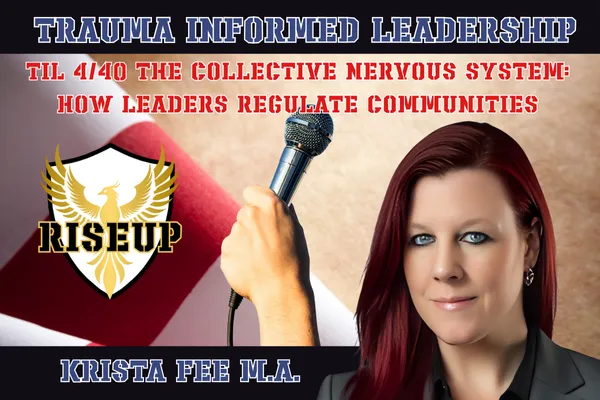
The Collective Nervous System: How Leaders Regulate Communities
The Collective Nervous System – How Leaders Regulate Communities
By Krista Fee M.A.
Leadership isn’t just about guiding individuals; it's also about inspiring them. It’s about guiding the collective nervous system.
When individuals carry trauma, their bodies and minds adapt to survive. But when an entire team, organization, or community carries trauma together, something bigger happens: the group itself begins to function like a single nervous system. Understanding this is the key to trauma-informed leadership. Because when you lead, you’re not just managing policies or logistics, you’re stewarding the regulation (or dysregulation) of everyone in the room.
A Community in Shock
Years ago, I worked with a school district reeling from the tragedy of a school shooting. Students were traumatized. Teachers were shaken. Parents were raw with fear. What struck me wasn’t just individual pain, it was the collective. Meetings were tense. Arguments flared quickly. Even routine decisions carried the weight of panic. The district’s leaders eventually realized: they weren’t just running schools. They were leading a nervous system on edge. Until they tended to that, nothing else would work.
The Science of the Collective Nervous System
Humans are wired for co-regulation. One nervous system influences another. Multiply that across a group, and you have a collective nervous system.
In a regulated group: Calm spreads. Decisions come easier. Trust deepens.
In a dysregulated group: Anxiety spreads. Chaos multiplies. Suspicion grows.
This is why leaders matter so much. A leader’s nervous system is not private; it’s public property. It’s the tuning fork the entire system aligns to.
Emotional Contagion: Why Your State Spreads
Neuroscience gives us a term for this: emotional contagion.
When a leader projects calm confidence, mirror neurons help others reflect that same steadiness.
When a leader panics or lashes out, the opposite happens, and fear multiplies.
That’s why one stressed-out manager can tank an entire department, while one grounded commander can hold a unit steady under fire. Your nervous system sets the tone.
Lessons from History and Today
Civil Rights Movement: Dr. Martin Luther King Jr.’s calm under pressure regulated entire communities. His presence helped prevent chaos, even in hostile and violent situations.
Hospital ICUs: Today, nurse managers in intensive care units embody this principle. During code blues, a steady leader keeps the team functional. When they panic, the room fractures.
The same medicine, the same training, but the leader's nervous system alters the outcome.
The Shadow Side: Dysregulated Leadership
Not all leaders regulate. Some leaders destabilize entire systems:
The police captain who yells unpredictably.
The corporate executive who spreads fear about layoffs.
The nonprofit director who micromanages from anxiety.
When leaders carry unhealed trauma, they project it into the system. Burnout, turnover, and mistrust follow.
This is why trauma-informed leadership isn’t optional. It’s survival.
My Own Lesson
I’ve lived this. In seasons where I carried my own unhealed trauma, I thought I was being passionate. However, my intensity spilled over into urgency, which unsettled my team. Once I learned the science and began regulating myself first, everything shifted. Meetings got calmer. Creativity rose. Trust deepened.
I realized that the most important foundation piece of the trauma-informed leadership puzzle is that the leader’s nervous system sets the tone for everyone else.
Five Practices for Regulating Communities
So how do you lead the collective nervous system?
Regulate Yourself First – Breathe. Ground. Settle before you enter the room.
Set the Pace, Not the Panic – Slow down enough to set a steady anchor for others.
Model Transparency Without Chaos – “This is hard, but we can handle it together.”
Create Safe Rhythms – Rituals, routines, and check-ins lower anxiety.
Invite Co-Regulators – Don’t carry the system alone. Build anchors around you.
Reflection Questions
When I walk into a room, do I bring regulation or dysregulation with me?
What are the ripple effects of my nervous system on my team or community?
How can I create rhythms that anchor collective safety?
Final Thought
Leadership is nervous system stewardship. When leaders regulate, communities rise. Safety spreads. Creativity flourishes. However, when leaders ignore their own dysregulation, communities tend to fracture. The choice begins with one body, one breath, one nervous system—you.
✨ Want to go deeper?
Book a call with Krista to see how trauma-informed leadership can transform your leadership—or schedule your organization’s custom training series.
👉https://calendly.com/riseupphoenix/compass
